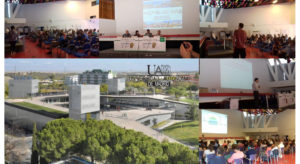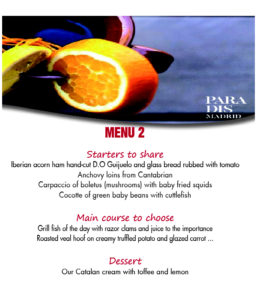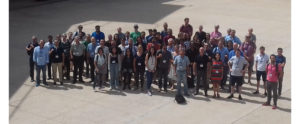(BioMolecular Electronics)
CECAM-PSI-K conference, Madrid, 27th -31st August 2018
Organizers: Linda A. Zotti, Juan Carlos Cuevas, Rubén Pérez
Venue: Universidad Autónoma de Madrid, Spain
Sponsors: PSI_K & CECAM (83%), Universidad Autónoma de Madrid (11%), IFIMAC (5%) and Catedra UAM-Fujitsu (2.5%)
BIOMOLECTRO was a very exciting event which took place this summer in Madrid. The aim of the conference was to bring together theoreticians and experimentalists working on the subject of electron transport through biomolecules such as proteins, peptides or DNA, as well as through bio-inspired devices and systems like bacterial nanowires. The conference was very successful, joining many world-leading scientists and proving that the field of biomolecular electronics is most certainly flourishing. This is thanks to the plethora of rich physical and chemical properties biomolecules have to offer (such as redox and optical functionalities as well as specific chemical recognition and self-assembly ) and to their potential to be employed in nanoscale devices.
The key merit of this conference was the unique joining of researchers from the fields of electron transport in molecular electronics, electron transfer in biology, and biosensors, and gathering their varied expertise and knowledge to produce many new ideas and directions. Please see below for the list of speakers and titles of their talks as well as the abstract book.
Some of the major scientific outcomes of the conference:
Striking results on protein-based junctions showed that these molecules can sustain surprisingly high currents and suggest that the transport in these junctions may be dominated by quantum tunneling, contrary to the common wisdom in biology. In particular, the growth of interesting experimental data and the lack of their complete understanding highlighted the need for (ab initio) quantum mechanical calculations of the electron transport in protein-based junctions.
The electron transport through amino acids and peptides turned out to be quite a controversial issue, based on the comparison between theoretical and experimental results which point to these systems being quite decent conductors when assembled in monolayers, but poor conductors when incorporated in single-molecule junctions.
DNA-based electronics was also confirmed as a promising field and the importance of different factors like sequence or the interaction with a substrate was revealed (putting an end to an initial phase of confusion and very disparate experimental results).
An emerging topic which was discussed as well was that of bacterial nanowires or cable bacteria. These biological wires are electrically conductive appendages produced by a number of bacteria and whose purpose is to facilitate long-range extracellular electron transfer, the mechanism of which remains poorly understood.
Moreover, certain processes taking place in molecules (such as chiral-induced spin selectivity, gold-thiolate formation, quantum interference, length dependence and polarizability) and the role they might play in biology were discussed.
A copy of the book of abstracts can be downloaded here:
To download some of the presentations instead, please click on the following links:
E. Alfinito: https://www.cecam.org/upload/files/file_4223.pdf
E. Leary: https://www.cecam.org/upload/files/file_4180.pdf
A. Nitzan: https://www.cecam.org/upload/files/file_4221.pdf
D. Beratan: https://www.cecam.org/upload/files/file_4184.pdf
A. Vilan: https://www.cecam.org/upload/files/file_4222.pdf
J.G. Vilhena: https://www.cecam.org/upload/files/file_4220.pdf
M. Elstner: https://www.cecam.org/upload/files/file_4122.pdf
Francisco Dominguez Adame: https://www.cecam.org/upload/files/file_4124.pdf
The following is a complete list of speakers:
Keynote Speakers:
- David Cahen, Weizmann Institute of Science, Israel
Efficient Electronic Transport across mono- and multi-layers of Proteins: the plot thickens
- Stuart Lindsay , Arizona State University, United States
Are Proteins Conductors or Insulators?
- Marcus Elstner , Karlsruhe Institute of Technology, Germany
Multi-scale methods for electron and exciton transfer
- LuisaTorsi, Università degli Studi di Bari “Aldo Moro”, Italy
Sensing at the physical limit with solution processed bioelectronic transistor
- Jochen Blumberger, University College London, United Kingdom
Electron transport through multiheme cytochromes: Insights from theory and molecular simulation
- Herre van der Zant , Delft University of Technology, The Netherlands
Transport through single biomolecules and wires
- David . Beratan , Duke University, Durham, United States
Schemes for directing electrons through biomolecules at low thermodynamic cost
- Spiros Skourtis, University of Cyprus, Cyprus
Bridge-mediated exciton transport: Pathways analysis of the donor-acceptor exciton coupling
- Ron Naaman , Weizmann Institute of Science, Israel
The chiral induced spin selectivity effect- Its role in defining properties of bio-molecules
Invited Speakers
- Eleonora Alfinito , Università del Salento, Italy
Proteotronics: a toolkit for bioelectronics
- Pau Gorostiza , University of Barcelona, Spain
Electrochemical tunneling microscopy and spectroscopy: from metal oxide films to individual redox proteins
- Ismael Diez Pérez, Kings College London, United Kingdom
Bio-inspired tunneling junctions
- Guilherme Vilhena , University of Basel, Switzerland
Understanding/Tuning the transport properties of biomolecules atom by atom
- Ayelet Vilan, Weizmann Institute of Science, Israel
Physical insight from molecular I-V traces using normalized differential conductance: the case of “doped” peptides
- Edmund Leary , University of Liverpool, United Kingdom
The single molecule conductance of porphyrins: voltage dependent conductance increase with length and atropisomerisation
- Sivan Refaely Abramson , University of California, United States
Charge transport through peptides: a computational perspective
- Fabian Pauly , Okinawa Institute of Science and Technology, Japan
Charge and heat transport through carbon-based single-molecule junctions
- Ioan Baldea , Universität Heidelberg , Germany
Impact of molecular conformation on transport and transport-related properties at the nanoscale
- David Waldeck , University of Pittsburgh, United States
Electron transport in nucleic acids. A comparison of DNA and PNA
- Abraham Nitzan , University of Pennsylvania, United States
Charge transport through redox molecular junctions
- Agostino Migliore , Duke University, United States
Biomolecular signaling mediated by DNA charge transport
- Christian Nijhuis , National University of Singapore, Singapore
Room-Temperature Tunnel Magnetoresistance across Biomolecular Tunnel Junctions Based on Ferritin
- Vladimiro Mujica, Arizona State University, United States
Polarizability as a molecular descriptor for conductance in molecular junctions
- Mohamed Y. El-Naggar , University of Southern California, United States
Nature’s Conductors: Extracellular Electron Transport in Microbial Redox Conduits
- Uri Peskin , Technion – Israel Institute of Technology, Israel
Towards Mechanical Stabilization of Molecular Electronic Devices:“Cooling by Heating” and more
- Josh Hihath , University of California, United States
Charge Transport in RNA and DNA: From Fundamentals to Function
- Dmitry Ryndyk, University of Bremen, Germany
Computational quantum transport with dephasing: DFTB+XT open software package
- Danny Porath, Hebrew University, Israel
Novel DNA-Based Molecules and Their Charge Transport Properties
- Artur Erbe , Helmholtz-Zentrum Dresden-Rossendorf, Germany
DNA-origami templated assembly of conducting nanostructures
- Yonatan Dubi , Ben Gurion University, Israel
Towards diodes and switches from single molecules
Conference Dinner:
Our conference dinner took place at Restaurante Paradis Madrid. We had an enjoyable time, sampling some typical dishes of excellent Spanish cuisine:
Below is a group picture with a good portion of participants who were brave enough as to strike a pose under a scorching sun in 40 degree temperature:
We are looking forward to the next meeting on Biomolecular Electronics! Who volunteers to organize it?





